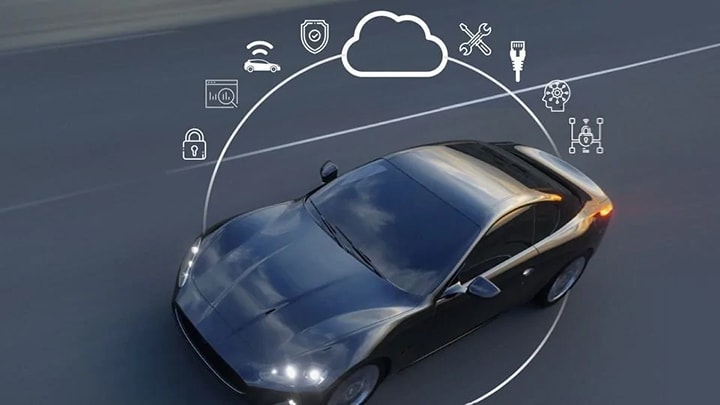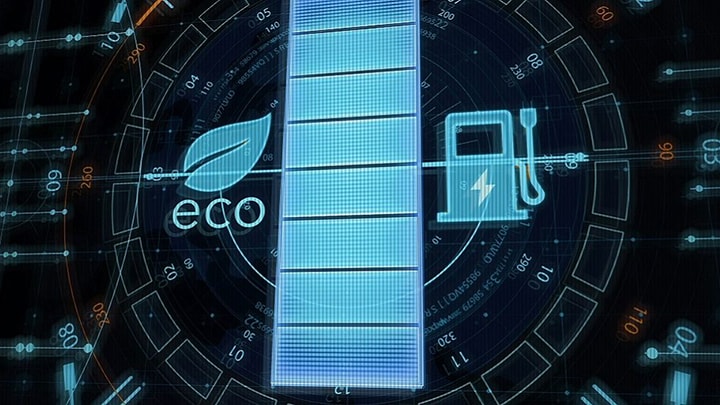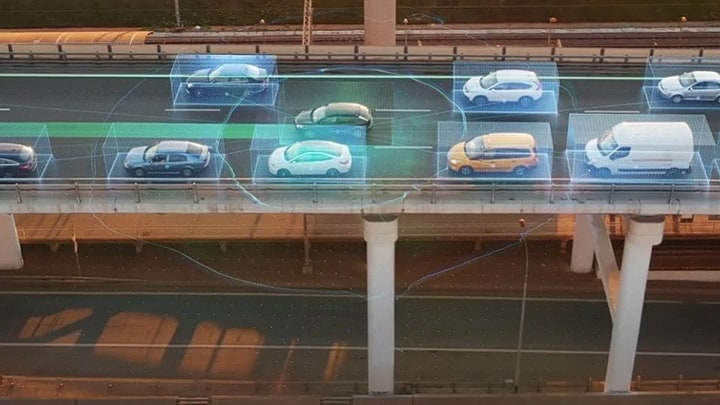Every 2 years in November, tens of thousands of people flock to Electronica for an immersive 4
days of groundbreaking electronics. This year was no different – it was an occasion to
share new ideas, and explore how they all connect. For NXP, it was an opportunity to show
what’s possible today with the secure connected car and glimpse into the future of the
completely autonomous vehicle.
Electronica’s ‘connected worlds – safe and secure’ theme is on
target with the industry’s focus. – Kurt Sievers, Head of NXP Automotive, opened electronica Monday evening to a
crowded auditorium in Munich.
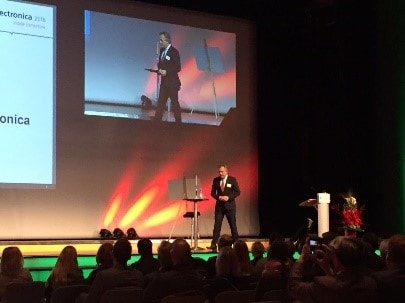 Semiconductors are the foundation of all innovation for tomorrow’s connected worlds, from
the tiniest wearables to self-driving cars and smart cities. But, he added, if you only connect
the world and forget about security, it can lead to adverse, even disastrous, consequences.
Semiconductors are the foundation of all innovation for tomorrow’s connected worlds, from
the tiniest wearables to self-driving cars and smart cities. But, he added, if you only connect
the world and forget about security, it can lead to adverse, even disastrous, consequences.
He shared the recent attack that took down a big chunk of the Internet for most of the U.S.
Eastern seaboard using smart – but unsecured – toasters, surveillance cameras and
other unsecured things.
It was a natural segue into the electronics industry’s focus on security, which was on
the minds of many in the audience.
A live experience of secure connected mobility
The connected car, and ultimately the completely autonomous vehicle, isn’t so far away.
That’s what NXP set out to show on the streets of Munich.
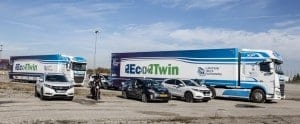 Siemens, Honda, DAF trucks, Cohda Wireless, Marben and Chemtronics joined NXP to show
intelligent traffic management, where cars, trucks, and motorcycles talked to traffic lights, road
works and each other. Called V2X (vehicle-to-everything) communications, vehicles and even ships
and drones, can connect and communicate to the infrastructure and other vehicles based on wireless
communications (IEEE802.11p).
Siemens, Honda, DAF trucks, Cohda Wireless, Marben and Chemtronics joined NXP to show
intelligent traffic management, where cars, trucks, and motorcycles talked to traffic lights, road
works and each other. Called V2X (vehicle-to-everything) communications, vehicles and even ships
and drones, can connect and communicate to the infrastructure and other vehicles based on wireless
communications (IEEE802.11p).
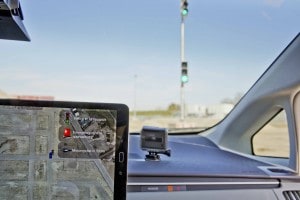

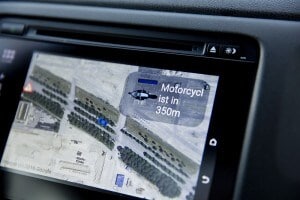 More than a dozen use cases were shown with the vehicle that “sees”
what’s ahead, around corners and over hills, detecting people and other vehicles. It syncs
with traffic signals to zip through green lights. It knows about an approaching ambulance,
pinpointing the location of the siren that would otherwise only be heard. It helps you avoid
accidents, reduces congestion and minimizes emissions.
More than a dozen use cases were shown with the vehicle that “sees”
what’s ahead, around corners and over hills, detecting people and other vehicles. It syncs
with traffic signals to zip through green lights. It knows about an approaching ambulance,
pinpointing the location of the siren that would otherwise only be heard. It helps you avoid
accidents, reduces congestion and minimizes emissions.
For more information, read about the connected vehicle experience in this blog,
Speed up autonomous cars.
Platooning system to bring 30 times faster reaction time
A new platooning
system, developed in partnership with DAF Trucks, sets out to achieve
30 times faster reaction time
when compared to human-controlled vehicles by 2017.
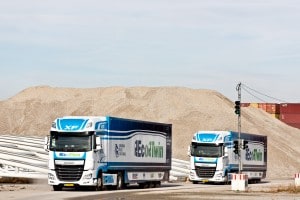
In platooning, a radar system is an essential element next to V2X. Two or more trucks wirelessly
link to form a platoon to save fuel, increase road safety, and cut down on emissions.
 The second truck, the follower, is in a semi-autonomous driving state, safely braking and
accelerating at high speeds in sync with the lead truck. If a car or another object cuts in front
of a truck, the radar detects it. Performance is critical to reliably and quickly detect objects,
allowing the vehicle to safely react.
The second truck, the follower, is in a semi-autonomous driving state, safely braking and
accelerating at high speeds in sync with the lead truck. If a car or another object cuts in front
of a truck, the radar detects it. Performance is critical to reliably and quickly detect objects,
allowing the vehicle to safely react.
Watch this
eTV episode with Lars Reger
who shares how platooning works.
New radar system detects and processes near-vehicle objects with higher accuracy and
safety The ability of a vehicle to make precise, safety-related decisions depends on its capacity
to accurately detect and classify objects. The new automotive S32 radar microcontroller offers four times the performance of its predecessor to safely detect and process any object in the vicinity of the car.
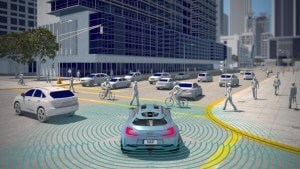 The higher performance of this MCU means higher accuracy and safety for applications such as
collision avoidance, lane change assist, autonomous emergency braking, radar cocooning with
360° perception or adaptive cruise control. In intelligent transport systems, vulnerable road
users (VRUs) like pedestrians, motorcycles and bicycles can be detected and tracked much faster.
The higher performance of this MCU means higher accuracy and safety for applications such as
collision avoidance, lane change assist, autonomous emergency braking, radar cocooning with
360° perception or adaptive cruise control. In intelligent transport systems, vulnerable road
users (VRUs) like pedestrians, motorcycles and bicycles can be detected and tracked much faster.
Get faster, more secure V2X development with Cohda Wireless
NXP now has full access to Cohda’s optimized algorithms for the rapid development
of V2X
standard enhancements and additional applications. This means that NXP can provide you with
enhanced firmware for the NXP RoadLink™ chipset.
 The streamlined software licensing helps you speed up your V2X and Connected Autonomous
Vehicle (CAV) developments to meet the needs of shorter time to market and even more secure
solutions.
The streamlined software licensing helps you speed up your V2X and Connected Autonomous
Vehicle (CAV) developments to meet the needs of shorter time to market and even more secure
solutions.
Automotive lighting is redefined with groundbreaking digital LED
A new
digital LED concept for automotive applications with the first LED product was unveiled by Inova
Semiconductors. This next-generation LED platform was rolled out by the Open ISELED Alliance. The
product,
available from Dominant Opto Technologies in early 2017, is the first developed under the umbrella of ISELED, an open alliance formed to provide a full
ecosystem for the new digital LED right from its very inception. The alliance includes Inova
Semiconductors, Dominant Opto Technologies, NXP, TE Connectivity and Pforzheim University.
NXP engages in the debates
NXP CEO Rick Clemmer joined renowned experts
from the semiconductor industry for the CEO Roundtable which focused on security (watch the replay).
At the Automotive Conference, several automotive sessions were led by NXP and partners
and security was a key topic, starting with a panel discussion on the secure
connected (self-driving) car with Lars Reger. Other sessions included multicore SOCs for
automotive with Stefan Singer, Marc Osajda covered MEMS and automotive and Timo van
Roermund led a session on security.
Additionally, Lars Reger and Davide Santo joined a panel discussion on automotive technology
transfer (read about it).
Here are just a few of the news highlights that were published live from
Electronica.
eTV (video):
Lars Reger interview: electronica 2016 eTV Automotive
eTV (video, German):
Kurt Sievers interview: electronica 2016 Trend Index
TechCrunch:
NXP’s new autonomous driving products focus on safety, self-driving trucks
Fortune:
Autonomous Cars to Drive Chip Sector Consolidation Says NXP
Forbes:
New NXP Technology Allows Tighter Truck Platooning
EETimes:
NXP Drives Truck Platooning
Electronics Weekly:
Electronica: Lorries self-convoy through the streets of Munich
eWeek:
New NXP Technologies Aimed at Autonomous Vehicles
Eetasia:
NXP radar MCU enables tighter truck platooning
NXP news:
NXP Quadruples Computing Power for Automotive Radar to Enable New Range of Semi-Autonomous
Capabilities
NXP news:
NXP and DAF Trucks Commit to Set New Benchmark in Truck Platooning: Thirty Times Faster than
Human Reaction Time
NXP news:
NXP and Cohda Wireless Enable Rapid V2X Development with Software Agreement
The story of the future of intelligent transportation doesn’t stop here. Keep up with
what’s shaping the industry by following NXP Automotive on Twitter
for the latest news and event updates.

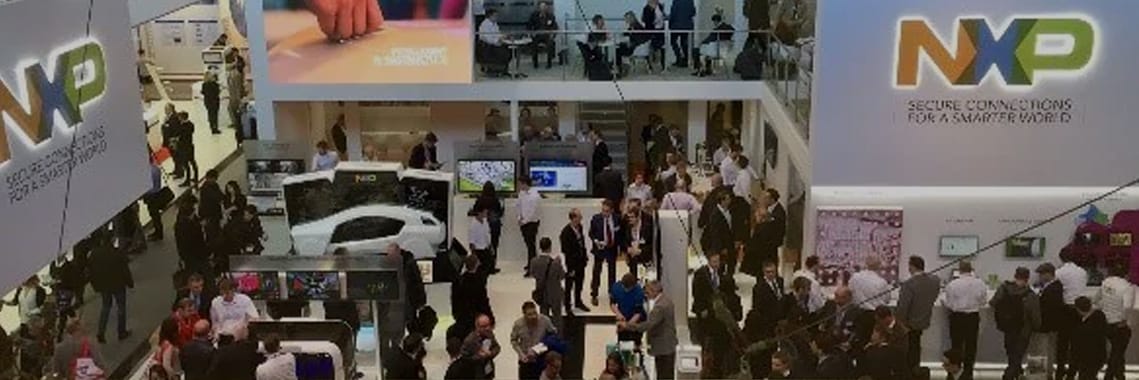
 Semiconductors are the foundation of all innovation for tomorrow’s connected worlds, from
the tiniest wearables to self-driving cars and smart cities. But, he added, if you only connect
the world and forget about security, it can lead to adverse, even disastrous, consequences.
Semiconductors are the foundation of all innovation for tomorrow’s connected worlds, from
the tiniest wearables to self-driving cars and smart cities. But, he added, if you only connect
the world and forget about security, it can lead to adverse, even disastrous, consequences.
 Siemens, Honda, DAF trucks, Cohda Wireless, Marben and Chemtronics joined NXP to show
intelligent traffic management, where cars, trucks, and motorcycles talked to traffic lights, road
works and each other. Called V2X (vehicle-to-everything) communications, vehicles and even ships
and drones, can connect and communicate to the infrastructure and other vehicles based on wireless
communications (IEEE802.11p).
Siemens, Honda, DAF trucks, Cohda Wireless, Marben and Chemtronics joined NXP to show
intelligent traffic management, where cars, trucks, and motorcycles talked to traffic lights, road
works and each other. Called V2X (vehicle-to-everything) communications, vehicles and even ships
and drones, can connect and communicate to the infrastructure and other vehicles based on wireless
communications (IEEE802.11p).


 More than a dozen use cases were shown with the vehicle that “sees”
what’s ahead, around corners and over hills, detecting people and other vehicles. It syncs
with traffic signals to zip through green lights. It knows about an approaching ambulance,
pinpointing the location of the siren that would otherwise only be heard. It helps you avoid
accidents, reduces congestion and minimizes emissions.
More than a dozen use cases were shown with the vehicle that “sees”
what’s ahead, around corners and over hills, detecting people and other vehicles. It syncs
with traffic signals to zip through green lights. It knows about an approaching ambulance,
pinpointing the location of the siren that would otherwise only be heard. It helps you avoid
accidents, reduces congestion and minimizes emissions.

 The second truck, the follower, is in a semi-autonomous driving state, safely braking and
accelerating at high speeds in sync with the lead truck. If a car or another object cuts in front
of a truck, the radar detects it. Performance is critical to reliably and quickly detect objects,
allowing the vehicle to safely react.
The second truck, the follower, is in a semi-autonomous driving state, safely braking and
accelerating at high speeds in sync with the lead truck. If a car or another object cuts in front
of a truck, the radar detects it. Performance is critical to reliably and quickly detect objects,
allowing the vehicle to safely react.
 The higher performance of this MCU means higher accuracy and safety for applications such as
collision avoidance, lane change assist, autonomous emergency braking, radar cocooning with
360° perception or adaptive cruise control. In intelligent transport systems, vulnerable road
users (VRUs) like pedestrians, motorcycles and bicycles can be detected and tracked much faster.
The higher performance of this MCU means higher accuracy and safety for applications such as
collision avoidance, lane change assist, autonomous emergency braking, radar cocooning with
360° perception or adaptive cruise control. In intelligent transport systems, vulnerable road
users (VRUs) like pedestrians, motorcycles and bicycles can be detected and tracked much faster.
 The streamlined software licensing helps you speed up your V2X and Connected Autonomous
Vehicle (CAV) developments to meet the needs of shorter time to market and even more secure
solutions.
The streamlined software licensing helps you speed up your V2X and Connected Autonomous
Vehicle (CAV) developments to meet the needs of shorter time to market and even more secure
solutions.
